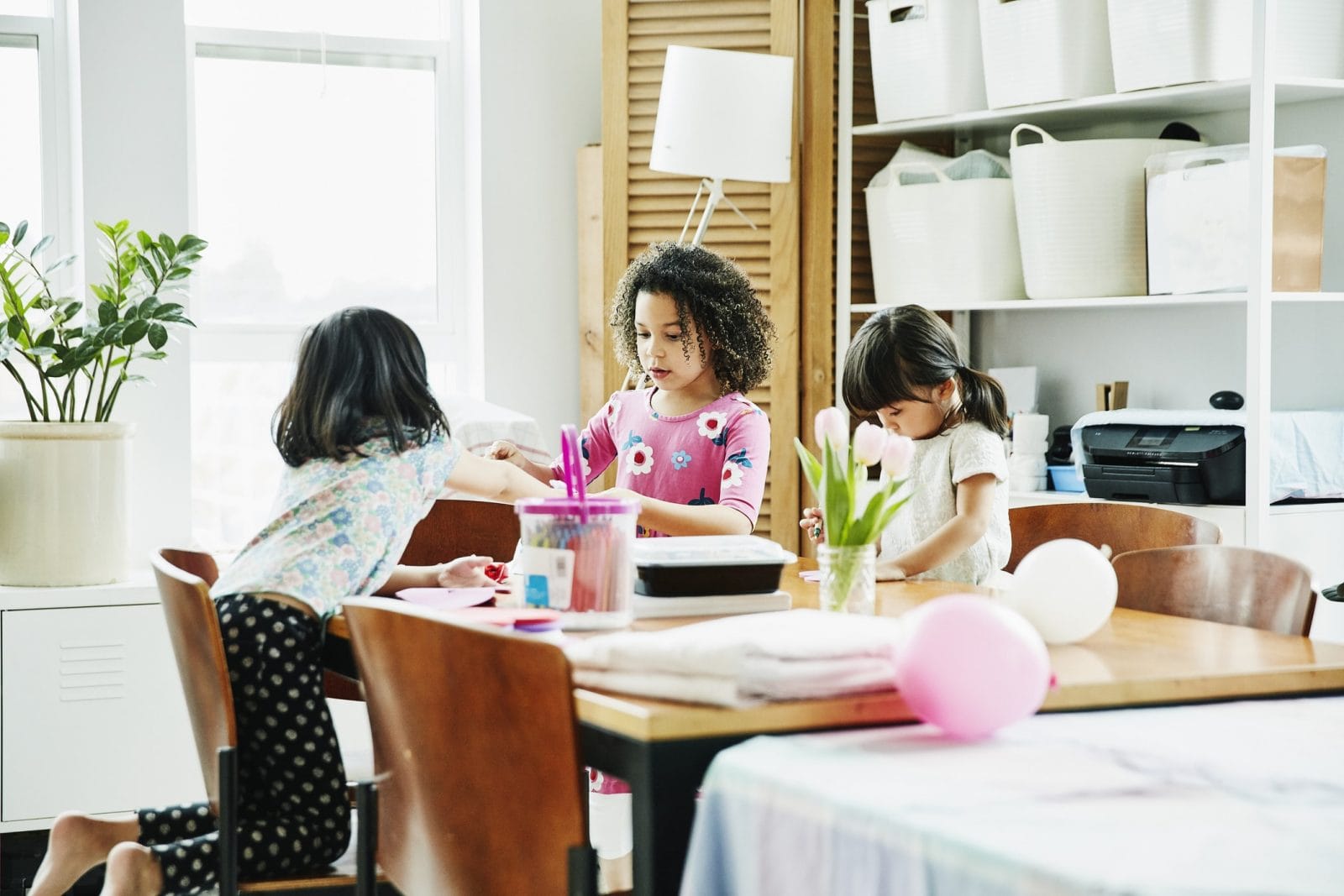30+ activities you can do with preschoolers to 10-year-olds

Including a sample homeschooling schedule.
Table of Contents
- Here's what I've learned from my own experience with homeschooling, including ideas, tips and a proposed structure for your day.
- Your kids are going to be okay.
- Kids are natural learners.
- Trust your children to find their own way to learn through play.
- Schedule one-on-one time.
- Schedule time for yourself, too.
- You don't have to structure every minute of your child's day.
- Here's a sample homeschooling schedule for kids
- Age-based homeschooling ideas
- Indoor exercise ideas for kids
With schools closed across the country to slow the spread of coronavirus, parents are understandably worried about keeping kids on track academically while keeping ourselves from stressing out.
Every family’s situation is different, but as an experienced homeschooler, I have good news for parents facing the challenge of at-home learning for the first time: While it isn’t always easy, with a few ideas and the right framing, it might not be as hard as you think.
Here’s what I’ve learned from my own experience with homeschooling, including ideas, tips and a proposed structure for your day.
Your kids are going to be okay.
First and most important, I want to assure you: Your kids are going to be okay. Humans have been educating themselves for thousands of years. Widespread schooling in the form we all know today is less than 150 years old. Historically, children have learned primarily from observing their elders, participating in a family and playing.
Kids are natural learners.
The building blocks of math, science, literacy and critical thinking are developed naturally through your child’s everyday activities—imaginary play, manipulating toys, moving their body and following their own curiosity.
Trust your children to find their own way to learn through play.
When your kid says, “I’m bored,” you can reply, “I hear you’re bored. I’m looking forward to seeing what you decide to do.” If your child is accustomed to a highly scheduled day or to getting your full attention whenever you’re home, it may take some time for them to learn the skill of alleviating boredom on their own. But time is what they have a lot of right now. You might be pleasantly surprised with what they come up with.
Schedule one-on-one time.
If you do nothing else, make sure you have at least 10 minutes of one-on-one time with each child each day, in which the child gets your full attention and gets to choose the activity. These times give your child a chance to reconnect with you and release built up tension. Believe me, this 10-minute investment will make the rest of your day go smoother.
Schedule time for yourself, too.
Make sure you schedule time for yourself every day, whether that means trading off childcare with your partner in the evening, letting the kids video chat with Grandma for an hour, or giving them the iPad for some video game time. Your mental health is the highest priority not just for you, but for your whole family.
You don’t have to structure every minute of your child’s day.
The degree to which you structure your child’s day is up to you and your child and what works for your family. There is no best way or right way to do homeschooling.
For parents working full-time, a hands-off approach may be the only option. If you’re working from home you may be able to block off time in your calendar to touch base with your kids, or, if you can afford to take breaks here and there, try some more hands-on activities.
If you think your family needs structure (and that’s completely understandable—kids and adults tend to crave structure), the below framework is flexible enough to adapt to your own style. Feel free to adjust as you go.
If you don’t want structure, feel free to skip the schedule and just use the ideas listed below. Every project suggested here is a valuable way for kids to learn through play.
Here’s a sample homeschooling schedule for kids
9:30 am: Morning family check-in
Share a snack and discuss the plans for the day. This can be collaborative between kids and parents. Read a story together or sing a song.
10 am–12 pm: Project
Set up your child with an age-appropriate project that they can work on independently or semi-independently. Ideas for projects by age group are listed in the next section, below.
It might be difficult to keep children focused on one project. Let it be okay for them to stop when they’ve had enough. Trust that their attention spans will grow with time. For younger kids, take a cue from preschools and have several activities laid out in different areas so they can move from one to the next.
Remember that it’s okay—even beneficial—for children to experience boredom. Boredom spawns imagination and creation.
12–12:30 pm: Lunch
12:30–1:30 pm: Movement
Get those bodies moving with some exercise or an outdoor activity. If you have a yard, try to do your work outside to encourage your kids to stay outside (if they’re like mine, they might come inside after a few minutes if you’re not there). Or take your kids on a walk or bike ride during a conference call. See more ideas for indoor and outdoor movement activities listed below!
1:30–3 pm: Quiet time
This is time for kids to nap, read, journal or listen. Parents of younger children know that all-important afternoon nap is worth whatever it takes, but there are also many guided meditation podcasts for children who have outgrown afternoon rest time.
Journaling can take whatever form feels most engaging: For younger kids, journaling can be drawing with crayons, or they can dictate a story to you. For older kids, journaling can be an ongoing story they are writing or diary entries.
Reading can be a chapter book for older kids, or audiobooks and children’s podcasts for the younger set. You can check out audiobooks from your local library without needing to leave your home. Repeat after me: Audiobooks are not cheating!
3–3:20 pm: Closing of ‘school’
Share a snack and discuss the day. What things went well and what didn’t? What are some ideas for activities the next days and weeks? If you like, use a whiteboard or post-its to plan for tomorrow. Sing a favorite song, or recite a cheer or rhyme to close the “school day.”
3:20–5 pm: Afternoon activities
For older kids who are independent learners, this could be time to go back to the same project they were working on earlier in the day, time to pick up work on a second project, or time to chat with friends and family.
For younger kids, though, this tends to be the hardest part of the day. It’s a great time to have your kids video chat with their relatives or friends. Try taking turns with other families having parents read aloud to each other’s children on video chat. For restless kids, play some upbeat music and let them dance or play instruments — toy drums, shakers, xylophones. Encourage imaginary play by offering dress-up costumes, dolls, and other make believe toys. Or cut yourself some slack if you need to let them use a screen to get through this time.
End your day by reading aloud together or sitting next to each other reading your own books.
Age-based homeschooling ideas
Ages 1-4
- Painting or coloring
- Collages
- Jigsaw puzzles
- Sorting beads or beans
- Playing with string, sticks, rocks, leaves, cardboard boxes
- Duplos, mega blocks, magnatiles, train tracks or any other sort of blocks
- “Folding” clothes or dish towels
- Water play with cups and bowls in the bathtub or outside
- Clay or play dough
- Gardening: pulling weeds, watering with a small watering can, digging in dirt
- “Paint” or “clean” the windows or floors using towels dampened with water
Ages 4–8
- Painting, coloring, collages
- Build a diorama
- Build a robot, contraption, or creature out of household items such as cardboard, toilet paper rolls, corks, shoe boxes, string, straws or cans.
- Make a maze or fort out of furniture
- Paper mache
- Sewing, knitting, felting
- Jigsaw puzzles
- Activity books with word searches, mazes, word scrambles, etc.
- Imaginary play with a storyline planned out by the child, with gathered props to help
- LEGO invention
- Science experiment kit
Ages 8+
- Cooking (Mollie Katzen has excellent cook books for kids)
- Multi-day projects creating a larger art piece or tool. For example, build a small car that runs with a motor, design and sew clothing, build a small boat that can float, create a doll from fabric or other materials, bind your own book
- Role playing games with friends on video chat
- Creative writing for role playing games
- Research project on a topic they’re excited about, culminating in an art piece or tool
- Math or logic puzzles
- Write and put on a play with siblings or friends on video chat
- Programming or other educational games on the computer
- Online classes
Indoor exercise ideas for kids
- Build an obstacle course out of chairs and pillows
- Play “the floor is hot lava” and jump from pillow to pillow
- Have a dance party
- Do gymnastics to music: somersaults, crab walks and donkey kicks for the little ones; cartwheels, handstands and bridges for older ones
- Race a sibling, parent, pet or imaginary friend from one room to the next, up and down the stairs or down the hallway. They can time it and race to improve their best time.
Remember, your kids are going to be okay. You’ve got this.


































